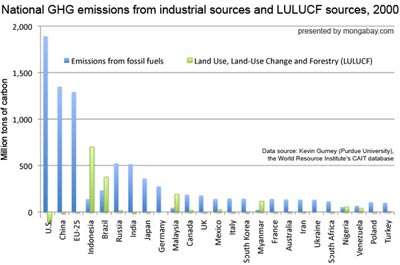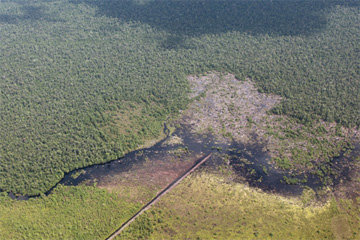A report released by the Indonesian government shows the country is the world’s third largest greenhouse gas emitter, largely as a result of the destruction of rainforests and carbon-dense peatlands. Indonesia accounts for 8 percent of global carbon dioxide emissions.
The ‘National Council on Climate Change’ report reveals that degradation and destruction of peatlands (45 percent) and forests (35 percent) account for 80 percent of Indonesia’s 2.3 billion tons of CO2 emissions per year. It projects Indonesia’s emissions will rise 57 percent to 3.6 billion tons by 2030, mostly due to continuing logging and conversion of natural ecosystems for agriculture and industrial plantations.
 |
Last year Indonesia announced it would allow the development of more than two million hectares of peatlands for oil palm agriculture. The policy would generate billions of tons of emissions based on a 2007 study that found that producing one ton of palm oil on peatland generates 15 to 70 tons of CO2 over 25 years as a result of forest conversion, peat decomposition and emission from fires associated with land clearance.
Marcel Silvius, Programme Manager of Wetlands International, a NGO that campaigns for the protection of wetlands around the world, says that Indonesia’s acknowledgment of emissions from drainage and destruction of peat swamps is a step forward, but it needs to do more to limit development of these carbon-dense lands.
“Wetlands International welcomes the recognition by the Indonesian government of the impact of peatland degradation on greenhouse gas emissions,” he said in a statement. “Now it is time to act and we therefore call on the Indonesian government to end policies that allow further deforestation and reclamation of peatlands.”
Compensation strategy
 Draining and clearing of peat forest in Central Kalimantan. Photo by Rhett A. Butler. |
By forecasting a substantial rise in greenhouse gas emissions from land use over the next 20 years, the report positions Indonesia to benefit handsomely from a proposed scheme that would reward tropical countries for reducing emissions from deforestation and degradation (REDD). Indonesia stands to earn tens of billions of dollars from the initiative should it successfully reduce deforestation over that period. It could earn even more if the U.N. includes reductions in emissions from peatlands degradation in the final climate agreement.
“This Indonesian report illustrates how enormous the contribution of peatland loss to climate change is, but also how cheap it is to avoid these emissions,” said Alex Kaat of Wetlands International. “This illustrates the need to address peatland loss in a new climate treaty.”
Related articles
Limit palm oil development to lands that store less than 40 tons of carbon/ha – study
(08/06/2009) A new study finds oil palm plantations store less carbon than previously believed, suggesting that palm oil produced through the conversion of tropical forests carries a substantial carbon debt.

(06/04/2009) A new paper by Oscar Venter, a PhD student at the University of Queensland, and colleagues finds that forest conservation via REDD — a proposed mechanism for compensating developing countries for Reducing Emissions from Deforestation and Degradation — could be economically competitive with oil palm production, a dominant driver of deforestation in Indonesia. The study, based on overlaying maps of proposed oil palm development with maps showing carbon-density and wildlife distribution in Kalimantan (Indonesian Borneo), estimates that REDD is financially competitive, and potentially able to fund forest conservation, with oil palm at carbon prices of $10-$33 per ton of carbon dioxide equivalent (tCO2e). In areas with low agricultural suitability and high forest carbon, notably peatlands, Venter and colleagues find that a carbon price of $2 per tCO2e would be sufficient to beat out returns from oil palm.
(06/04/2009) Indonesia’s decision earlier this year to allow conversion of up to 2 million hectares of peatlands for oil palm plantations is “a monumental mistake” for the country’s long-term economic prosperity and sustainability, argues an editorial published in the June issue of Frontiers in Ecology and the Environment.
Biofuels can reduce emissions, but not when grown in place of rainforests
(07/22/2008) Biofuels meant to help alleviate greenhouse gas emissions may be in fact contributing to climate change when grown on converted tropical forest lands, warns a comprehensive study published earlier this month in the journal Environmental Research Letters. Analyzing the carbon debt for biofuel crops grown in ecosystems around the world, Holly Gibbs and colleagues report that “while expansion of biofuels into productive tropical ecosystems will always lead to net carbon emissions for decades to centuries… [expansion] into degraded or already cultivated land will provide almost immediate carbon savings.” The results suggest that under the right conditions, biofuels could be part of the effort to reduce humanity’s carbon footprint.
Palm oil is a net source of CO2 emissions when produced on peatlands
(12/17/2007) Researchers have confirmed that converting peat forests for oil palm plantations results in a large net release of carbon dioxide, indicating industry claims that palm oil helps fight climate change are unfounded, at least when plantations are established in peatlands.